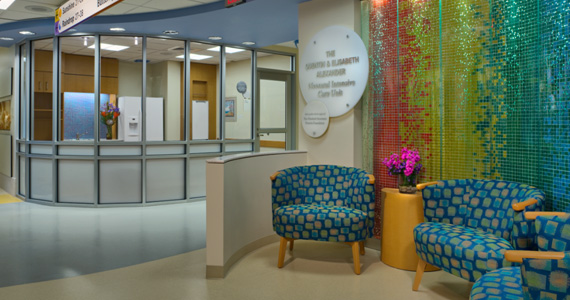

In today’s leading pediatric facilities, including those designed by Array such as University Hospitals Rainbow Babies Children’s Hospital in Cleveland, Ohio, art installations become an experience not only for the patient but the entire care team around the patient. Gone are the days of volunteer groups raising money for a piece or two in the facility – now hospitals are investing in collections that not only pay the facility back over time with their appreciation in value but they are integrating art into their buildings in unique ways.
Art can be a tool for wayfinding and learning your way around a building. Visitors to some of the country’s leading pediatric centers aren’t always fortunate to stay for a one-day visit. Many are dealing with long-term illnesses with their children. The care team around these children consists of extended families of parents, grandparents, siblings and friends. Each individual will have a different experience in the hospital and have different needs. Art in these facilities can be everything from sculptures hung from ceilings, to glass in the curtain wall to cast shapes imbedded in the floor material. These pieces can be tied to key destinations in the facility and help to create landmarks that aid in wayfinding.
Art can start to form the journey for the patient. For example, if there is a nature theme for the building based on its geographic location, the art can support the theme by animal or plant. These objects can become the basis to pull accent colors and patterns into the interior furnishings. An education program can be developed throughout the facility that helps patients learn how the nature around them works by explaining habitats and eating habits of the featured animals. While traveling from one department to another, patients learn about other animals and plants. They may begin to notice how colors evolve and the traditional art or sculpture in the space supports the theme. All of this helps form a positive journey through the facility for the patients and their families.
In many cases, these pieces are also used as therapy for the patients. The sculpture or other three-dimensional art can be touched and climbed on. When accessible to patients, these become part of their road to recovery to stand up and touch a part of the piece that they could not touch a few days ago, or to follow a floor pattern on the ground a bit further than the day before. Children can draw on glass over connect-the-dot art in a patient room to help create their own version of the art piece.
Art pieces can also help create a positive distraction for the loved ones as they seek quiet moments in a meditation space or wander in a rooftop garden. Art integrated into the landscape design can be appreciated from a child’s hospital room window for those too sick to travel outside. All of the art in a facility can then be organized into a walking tour so loved ones and patients can explore the different departments to see the variety of installations as they spend their time healing in the hospital.
In the end, it may not be the art that ultimately heals a child, but it hopefully will be one of the positive memories the child and family have once they are discharged.





Pingback: Can Art Heal in Pediatrics? | Office Environments Of The Future | Scoop.it
Art is an amazing tool, and I am so happy their are designers who understand how to create Enviroments rather than generic spaces.